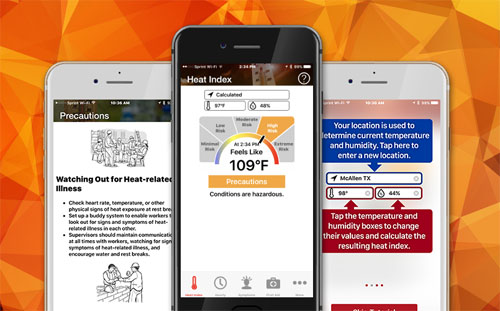NIOSH and OSHA Introduce Improved Heat Safety App for Outdoor Workers
Mobile app helps workers stay safe in hot weather
An updated app for smart phones and other mobile devices can help workers stay safe when working outdoors in hot weather. The free app was redesigned by CDC’s National Institute for Occupational Safety and Health (NIOSH), along with the U.S. Department of Labor’s Occupational Safety and Health Administration (OSHA).

An updated app for smart phones and other mobile devices can help workers stay safe when working outdoors in hot weather.
The OSHA-NIOSH Heat Safety Tool mobile app, for iOS and Android devices, determines heat index values – a measure for how hot it feels – based on temperature and humidity. Workers exposed to hot and humid conditions, including construction workers, landscapers, farmers, and others, are encouraged to use the app to check weather conditions if they will be outdoors for short or long periods during the summer heat.
“With the hot summer months on our doorstep, this app is a valuable tool for employers and workers to help prevent heat-related illnesses,” said John Howard, M.D., director of NIOSH. “In many cases, workers rely on their employers to provide opportunities for taking rest breaks and drinking water. This app puts life-saving information at the fingertips of both supervisors and workers to inform them when they need to take precautions to stay safe at the worksite.”
Extreme heat can be deadly
Extreme heat causes more deaths than any other weather-related hazard; each year more than 65,000 people seek medical treatment for extreme heat exposure. In 2014 alone, 2,630 workers suffered from heat-related illness, and 18 died from heat stroke and related causes on the job, according to OSHA.
Work-related exposure to heat can also result in reduced productivity and growing risk of injuries, such as those caused by sweaty palms, fogged-up safety glasses, and cognitive impairment (that is, mental confusion, impaired judgment, and poor coordination).
The app, an updated version of OSHA’s original Heat Safety Tool, uses the device’s geolocation capabilities to pull temperature and humidity data from National Oceanic and Atmospheric Administration satellites to determine the heat index. The app shows the current risk level (minimal, low, moderate, high, or extreme) and forecasts the hourly heat index throughout the entire workday giving employers information they can use to adjust the work environment as needed to protect workers.
“We applaud NIOSH for updating this important worker safety tool. Workers are most vulnerable in the first few days of working in the heat and the app helps users to calculate risk levels and learn the protective measures they can take to prevent heat illness,” said Dorothy Dougherty, Deputy Assistant Secretary of Labor for Occupational Safety and Health. “Being aware of the risks, gradually building a tolerance, and taking the necessary precautions can keep workers safe and save lives.”
How to stay safe outdoors in extreme heat
In addition to calculating the heat index, the app provides users with specific NIOSH and OSHA recommendations for protection against the heat based on the calculated risk level. This includes information about staying cool, proper hydration, and scheduling rest breaks. Recommendations are based on the 2016 publication NIOSH Criteria for a Recommended Standard: Occupational Exposure to Heat and Hot Environments, which was recently updated to reflect the latest science.
Some examples of NIOSH recommendations that can be applied in many different outdoor workplaces include:
● Limit time in the heat and/or increase recovery time in a cool environment.
● Increase the number of workers per task.
● Train supervisors and workers about heat stress, including symptoms of heat-related illness, first aid, and risk factors.
● Use a buddy system where workers observe each other for signs of heat intolerance.
● Provide adequate amounts of cool, potable water near the work area and encourage workers to drink frequently.
● Use a heat alert program (additional written guidelines) whenever the weather service forecasts that a heat wave is likely to occur.
● Develop a plan to get employees acclimatized to hot weather and to increase physical fitness.
Source: U.S. Centers for Disease Control and Prevention
- 288 reads
Human Rights
Ringing FOWPAL’s Peace Bell for the World:Nobel Peace Prize Laureates’ Visions and Actions

Protecting the World’s Cultural Diversity for a Sustainable Future

The Peace Bell Resonates at the 27th Eurasian Economic Summit

Declaration of World Day of the Power of Hope Endorsed by People in 158 Nations

Puppet Show I International Friendship Day 2020

